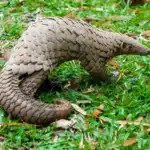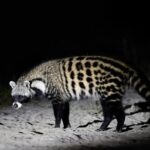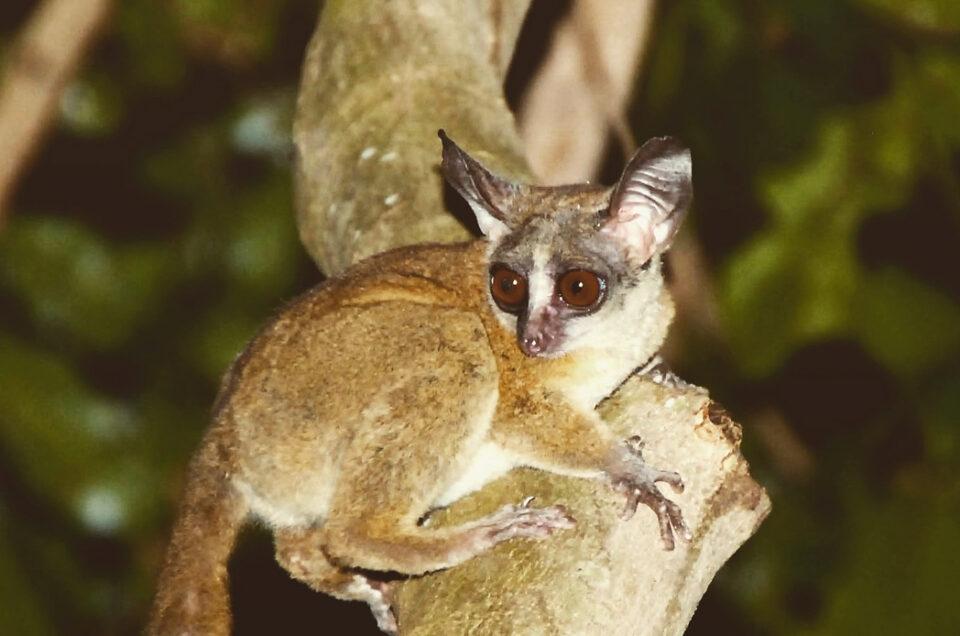The greater bush baby in Kibale Forest National Park, also known as the eastern needle-clawed bush baby or spectacled galago is a nocturnal primate easily recognized by its large eyes and distinctive dark rings around them. This is a small furry animal in Africa that prefers a secretive nocturnal lifestyle. Its scientific name is galago, but the locals call this creature bush baby.
The eastern needle-clawed bush baby, also known as the spectacled galago, is the largest of the three species found in Kibale Forest. These primates weigh between 250-450 grams and are easily recognizable by the distinctive dark rings around their eyes, which resemble spectacles.
Bush babies are nocturnal creatures, meaning they are active during night hours. Because of this, they have certain characteristics that allow them to survive and thrive during the night. These characteristics are their voice, ears, and eyes. Bush babies’ loud cries enable them to communicate to one another.
But the wet nose is not the only distinguishing characteristic. We can also notice that their thumb does not oppose other fingers so much and they have elongated “grooming” claws to care for their hair. In addition, bush babies have a poor ability to distinguish colors. This is due to their predominantly nocturnal lifestyle.
Bush babies have also learned to get along with humans, getting quite close to their homes. To see them, you often do not need to go deep into the African wilderness. Just choose a hotel located among lush greenery with abundant trees and bushes. A perfect example is near some lodges and Hotels, This area is the heart of East Africa and home to several species of primate galago.
In Kibale forest national park, these saucer-eyed primates are best spotted during a guided night walk. Bush babies in Kibale forest national park are spotted by tracing their amazing baby-like cry in a tree canopy and then shining a torch light onto it. You’ll be surprised by its extremely big eyes
Bush babies are nocturnal and arboreal feeders. Their favorite food is grasshoppers, but they will also consume small birds, fruits, seeds and flowers. Insect prey like beetles and moths small rodents’ frogs and lizards small birds and their eggs.
Most galago species live in small groups or prefer to lead solitary lifestyles. This is especially true of male bush babies. Females, on the other hand, live with their offspring. And as the infants grow up, male offspring leave and female offspring remain, forming a natal group of relatives. In some galago species, males form bachelor communities. So their social life is not that poor.
But more often galago lives individually. They mark their territory and strictly ensure that no one crosses its boundaries. To do this, they urinate on their paws and, moving them, climb trees, leaving traces of their scent. This behavior is referred to as urine washing.
At night, these small primates return to their nests made out of leaves and small twigs. In some cases, they use abandoned bird nests or even beehives. Sometimes, bush babies while remaining solitary during the active night phase, form a kind of temporary community by sleeping near each other during the daytime. This is safer for them because if a predator gets close, the first galago to detect danger will wake up the others by crying.
In addition to peaceful forms of interaction, human activity can harm these little primates. In general, their conservation status is of the “least concern”. Although for some species a decrease in populations or a decrease in habitat areas is recorded. Here humans affect bush babies indirectly by expanding farmland or cutting down forests. This leads to the direct expulsion of animals from their native environments. And also to a decrease in the food supply for the galago populations.
Thick tailed bush baby sleeps together during the day, but split up at night to forage. They have been found to move up to one kilometer through the night. They live in small groups of 2-6 individuals.
Predators include Mongooses, genets, jackals, domestic cats and dogs, snakes and snakes. Several other primates have also been observed eating bush babies, such as grey-cheeked Mangabeys and blue monkeys. There’s even evidence that chimpanzees fashion spears to kill and extract bush babies from their burrows.
As superior primates and closest relatives of humans, these apes even made primitive weapons that were used to kill bush babies. The famous chimpanzee researcher Jane Goodall was the first to notice in the 1960s that these clever apes were making tools such as sharpened sticks for extracting termites from their high mound dwellings. Chimpanzees have also been known to excitedly and efficiently hunt. Besides, it is safer on tree branches than on the ground. However, the galago still has natural enemies.
Gestation is about three to four months; young usually number one or two. Before 1980 only six species were recognized, but studies since then, especially of their vocalizations, have resulted in the identification of perhaps as many as 20 species.
Bush babies can live up to 20 years in captivity! It is a long commitment.








